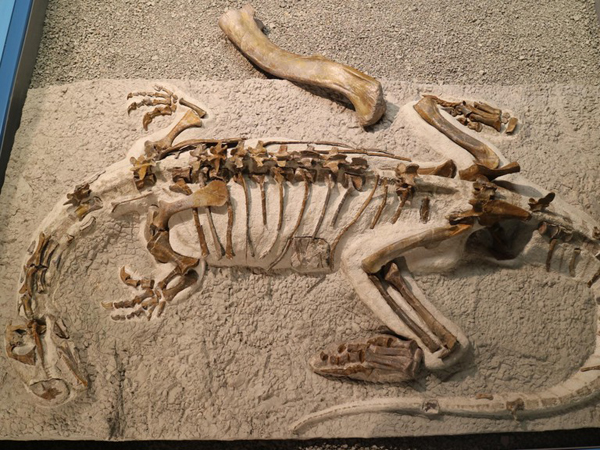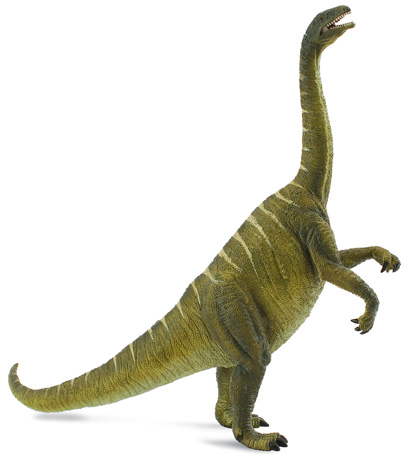Plateosaurus Juveniles Looked a Lot Like Adult Plateosaurus
Plateosaurus Juveniles Looked a Lot Like Adult Plateosaurus
A team of scientists including researchers from the University of Bonn (Germany), have concluded that baby Plateosaurus were miniature versions of their parents, that is, this Late Triassic member of the Sauropodomorpha had a largely fully developed morphology at an early age. Unlike most other long-necked dinosaurs, its body proportions did not change dramatically as the creature grew and matured.
This research published this month in the journal Acta Palaeontologica Polonica, focuses on the analysis and study of a juvenile specimen of Plateosaurus discovered in 2015 at the Frick fossil site in Switzerland. Plateosaurus is one of the best known Late Triassic dinosaurs due to the discovery of extensive bone beds consisting of the fossilised bones of hundreds of individual animals, but to find an almost complete specimen of a juvenile is an exceptionally rare event in vertebrate palaeontology.
Studying Plateosaurus Juveniles
Explaining the lack of juvenile specimens to study, lead author Professor Martin Sander (University of Bonn) stated:
“The smaller individuals probably did not sink into the mud quite as easily and are therefore underrepresented at the bone beds.”
The young Plateosaurus was nicknamed “Fabian” and it looked very similar to its parents even at a young age. The fact that Plateosaurus showed a largely fully developed morphology at an early age could have important implications for how the young animals lived and moved around.
“Fabian” The Juvenile Plateosaurus Specimen

Picture credit: Sauriermuseum Frick, Switzerland
The picture (above), shows the juvenile Plateosaurus specimen that was the focus of the study, (top) an adult Plateosaurus femur (thigh bone) for comparison.
Plateosaurus – An Early European Giant
Known from the Norian faunal stage of the Late Triassic, this herbivorous dinosaur roamed much of what is now North America, Greenland and continental Europe between 222 and 210 million years ago. Size estimates vary but some palaeontologists have postulated that Plateosaurus reached lengths of around ten metres and weighed up to four tonnes. It was one of the largest terrestrial animals on the planet during the Late Triassic.
A Model of a Plateosaurus Dinosaur
The picture (above) shows a CollectA Age of Dinosaurs Plateosaurus figure.
To view this model range: CollectA Age of Dinosaurs Figures.
Professor Martin Sander and his team used comparative anatomy to examine “Fabian” and based on the length of the vertebrae they estimate that this dinosaur was about 2.3 metres long when it died with a body weight of around 40-60 kilograms. The small size of the specimen led the team to propose that the fossils represented a very young animal, this was confirmed when bone sutures in the spinal column were found not to have fully fused.
Young and Old Plateosaurus Resembled Each Other Anatomically
The detailed analysis demonstrated that the young dinosaur resembled its older relatives in anatomical details, such as the pattern of the laminae on the vertebrae (bony struts connecting parts of the vertebrae and helping to protect the spinal cord).
Co-author Darius Nau (University of Bonn), commented:
“The hands and neck of the juveniles may be a little longer, the arm bones a little shorter and slimmer. But overall, the variations are relatively small compared to the variation within the species overall and also compared to other dinosaur species”.
In contrast, the juveniles of the related Mussasaurus for example, were quadrupedal when young, whilst the adults appear to have been fully bipedal.
Implications for the Plateosaurus Genus
Much lighter than the adults, the body proportions of a young Plateosaurus were very similar to those of a mature animal, although an adult Plateosaurus was perhaps as much as a hundred times heavier than “Fabian”. However, it is conceivable that the morphological development differed greatly from individual to individual, depending on the climatic conditions or the availability of food and other resources within the environment. Such differences are still seen in extant reptile populations.
The scientific paper: “Postcranial osteology of the first early-stage juvenile skeleton of Plateosaurus trossingensis from the Norian of Frick, Switzerland” by Darius Nau, Jens N. Lallensack, Ursina Bachmann, and P. Martin Sander published in Acta Palaeontologica Polonica.
Visit the Everything Dinosaur website: Everything Dinosaur.


